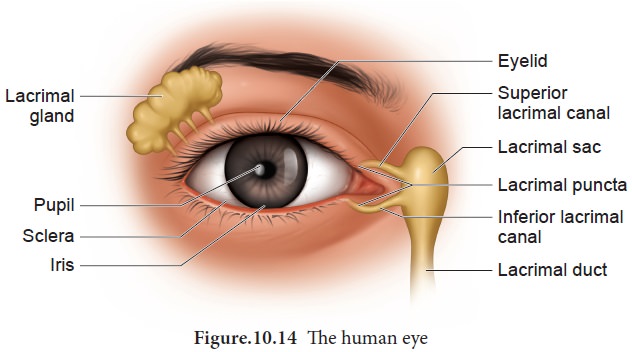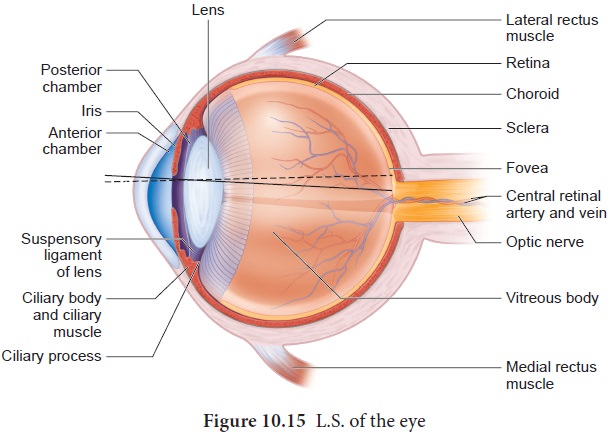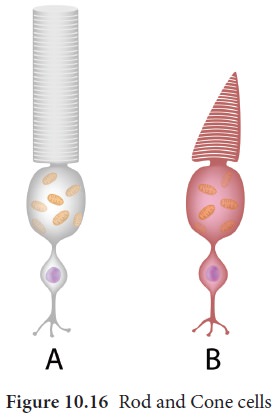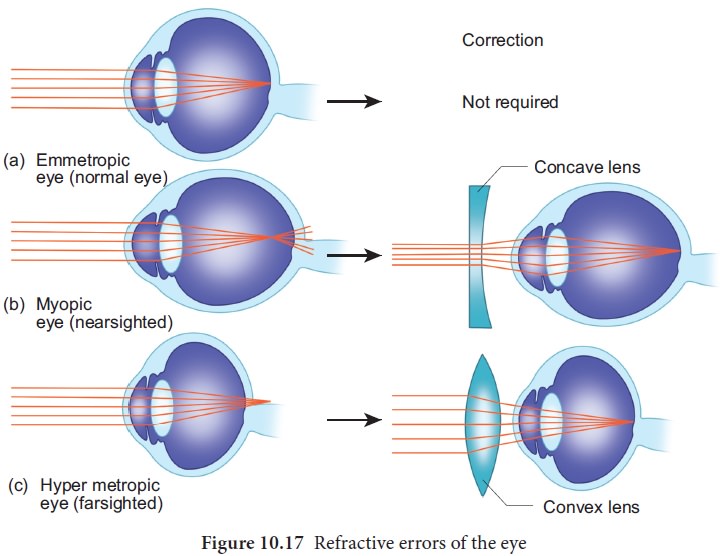Chapter: 11th Zoology : Chapter 10 : Neural Control and Coordination
Photoreceptor - Eye
Photoreceptor - Eye
Eye is the organ of vision; located in the orbit of
the skull and held in its position with the help of six extrinsic muscles. They
are superior, inferior, lateral, median
rectus muscles, superior oblique and
inferior oblique muscles. These muscles aid in the movement of the eyes and they receive their nerve innervation from
III, IV and VI cranial nerves. Eyelids, eye lashes and eye brows are the
accessory structures useful in protecting the eyes. The eye lids protect the
eyes from excessive light and foreign objects and spread lubricating secretions
over the eye balls.
Eyelashes and the eyebrows help to protect the
eyeballs from foreign objects, perspiration and also from the direct rays of
sunlight. Sebaceous glands at the
base of the eyelashes are called ciliary
glands which secrete a lubricating fluid into the hair follicles. Lacrymal glands, located in the upper
lateral region of each orbit, secrete tears. Tears are secreted at the rate of
1mL/day and it contains salts, mucus and lysozyme
enzyme to destroy bacteria.
The conjunctiva is a thin, protective mucous
membrane found lining the outer surface of the eyeball (Figure 10.14).

The eye has two compartments, the anterior- and posterior compartments. The anterior compartment has two chambers,
first one lies between the cornea and iris and the second one lies between the
iris and lens. These two chambers are filled with -watery
fluid called aqueous humor. The
posterior compartment lies between the lens and retina and it is filled with a
jelly like fluid called vitreous humor that helps to retain the spherical
nature of the eye. Eye lens is
transparent and biconvex, made up of long columnar epithelial cells called lens fibres. These cells are
accumulated with the proteins called crystalline.
The eye ball
The eye ball is spherical in nature. The anterior
one - sixth of the eyeball is exposed; the remaining region is fitted well into
the orbit. The wall of the eye ball consists of three layers: fibrous Sclera, vascular Choroid and sensory Retina
(Figure 10.15).

The outer coat is composed of dense non -vascular
connective tissue. It has two regions: the anterior cornea and the posterior
sclera. Cornea is a non-vascular transparent coat formed of stratified squamous
epithelium which helps thecornea to renew continuously as it is very vulnerable
to damage from dust. Sclera forms the white of the eye and protects the
eyeball. Posteriorly the sclera is innervated by the optic nerve. At the
junction of the sclera and the cornea, is a channel called ‘canal of schlemm’ which continuously drains out the excess of
aqueous humor.
![]()
Choroid is highly vascularized pigmented layer that nourishes all the eye layers and its pigments absorb light to prevent internal reflection.
Anteriorly the choroid thickens to form the ciliary body and iris. Iris is the coloured portion of the eye lying between the cornea and lens. The aperture at the centre of
the iris is the pupil through which
the light enters the inner chamber. Iris is made of two types of muscles the dilator papillae (the radial muscle) and the sphincter papillae (the circular muscle).In the bright light, the circular muscle in
the iris contract; so that the size of pupil decreases and less light enters
the eye. In dim light, the radial muscle in the iris contract; so that the
pupil size increases and more light enters the eye. Smooth muscle present in
the ciliary body is called the ciliary
muscle which alters the convexity of the lens for near and far vision. The
ability of the eyes to focus objects at varying distances is called accommodation which is achieved by suspensory ligament, ciliary muscle and ciliary body. The suspensory ligament
extends from the ciliary body and helps to
hold the lens in its upright position. The ciliary body is provided with
blood capillaries that secrete a watery fluid called aqueous humor that fills the anterior chamber.
Retina forms the inner most layer of the eye and it contains two regions: A sheet of pigmented epithelium (non visual part) and neural visual regions. The neural retina layer contains three types of cells: photoreceptor cells – cones and rods (Figure 10.16 and Table 10.6), bipolar cells and ganglion cells.

The yellow flat spot at the centre of the posterior
region of the retina is called macula lutea which is responsible for
sharp detailed vision. A small depression present in the centre of the yellow
spot is called fovea centralis which
contains only cones. The optic nerves and the retinal blood vessels enter the
eye slightly below the posterior pole, which is devoid of photo receptors;
hence this region is called blind spot.

Mechanism of vision
When light enters the eyes, it gets refracted by the cornea, aqueous humor and lens and it is focused on the retina and excites the rod and cone cells. The photo pigment consists of Opsin, the protein part and Retinal, a derivative of vitamin A. Light induces dissociation of retinal from opsin and causes the structural changes in opsin. This generates an action potential in the photoreceptor cells and is transmitted by the optic nerves to the visual cortex of the brain, via bipolar cells, ganglia and optic nerves, for the perception of vision.
Refractive errors of eye
Myopia (near sightedness): The affected person can see the nearby objects but not the distant objects. This condition may result due to an elongated eyeball or thickened lens; so that the image of distant object is formed in front of the yellow spot. This error can be corrected using concave lens that diverge the entering light rays and focuses it on the retina.
Hypermetropia (long sightedness): the affected person can see only the distant objects clearly but not the objects nearby. This condition results due to a shortened eyeball and thin lens; so the image of closest object is converged behind the retina. This defect can be overcome by using convex lens that converge the entering light rays on the retina.
Presbyopia:
Due to
aging, the lens loses elasticity and the power of accommodation. Convex lenses
are used to correct this defect.
Astigmatism is due to the rough (irregular) -
curvature of cornea or lens. Cylindrical glasses are used
to correct this error (Figure 10.17).
Cataract:
Due to
the changes in nature of protein, the lens becomes opaque. It can be corrected
by surgical procedures.

Related Topics